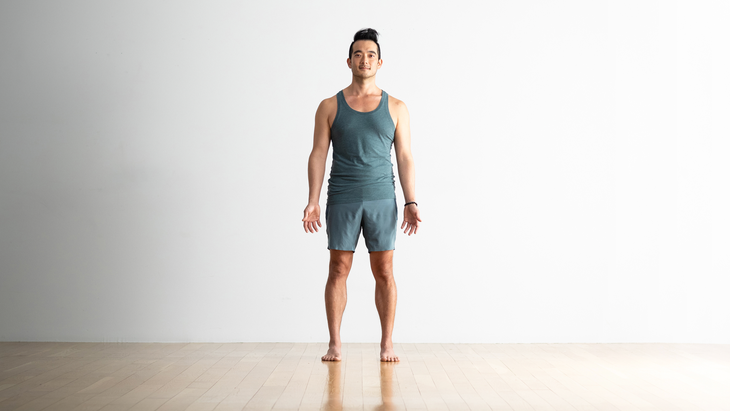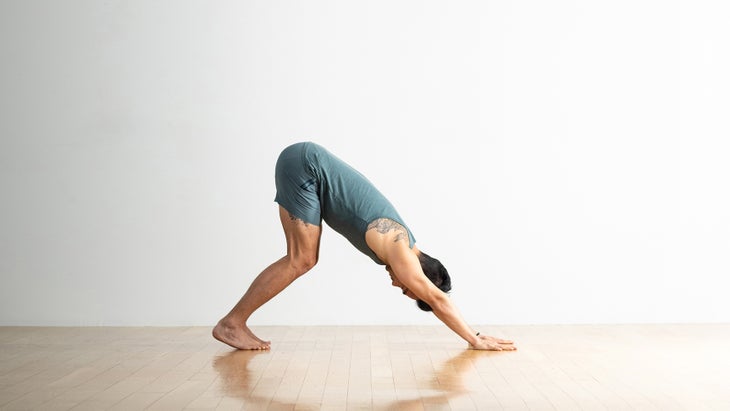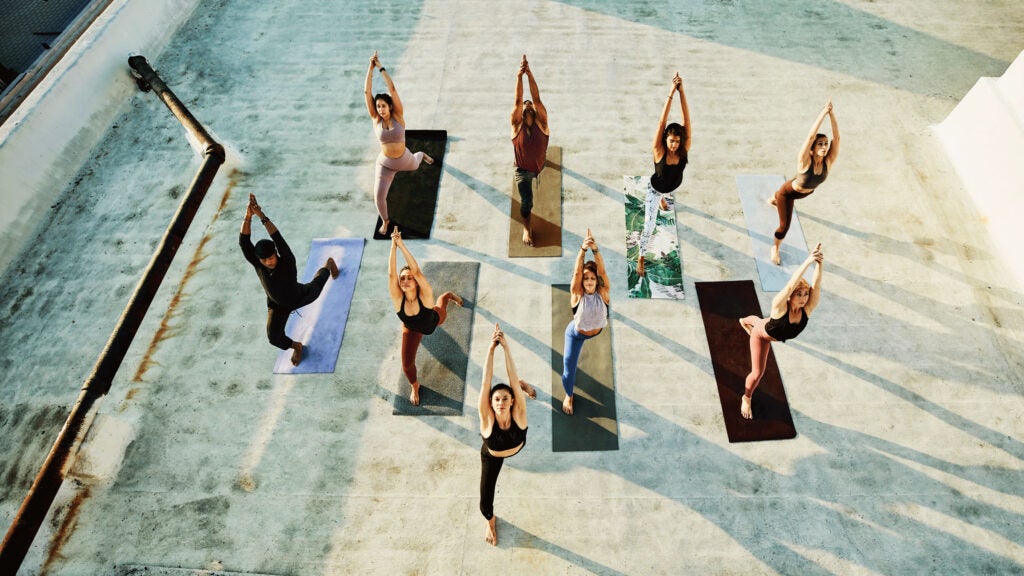“], “filter”: { “nextExceptions”: “img, blockquote, div”, “nextContainsExceptions”: “img, blockquote, a.btn, a.o-button”} }”>
Heading out the door? Read this article on the new Outside+ app available now on iOS devices for members!
>”,”name”:”in-content-cta”,”type”:”link”}}”>Download the app.
“Even an old person becomes young by constantly practicing mula bandha.” I sometimes share this quote from the Hatha Yoga Pradipika when I teach classes and observe students immediately become 10 times more interested in what I’m saying.
When I began practicing yoga years ago, I regarded the poses exclusively as a workout and completely ignored the complexity of the ancient philosophy underlying the practice. This meant I also ignored the bandhas. After I began to explore the other aspects of yoga, I came to understand these energetic locks in the body as one of the most important “secrets” of yoga.
What Exactly Are Bandhas?
In Sanskrit, the term “bandha” means to lock, hold, or tighten. On a physical level, bandhas can be explained as the strategic activation and engagement of certain muscles. On an energetic level, these intentional contractions are believed in yoga tradition to subtly redirect and conserve the flow of life force, or prana, within the body.
When engaged, a bandha functions as an internal valve. It retains prana that is believed to otherwise slowly dissipate from the body. Imagine unengaged bandhas as a car tire that’s constantly leaking air due to a missing valve stem cap. You’re able to drive but you need to refill it often.
Understanding and working with the bandhas not only stops the outward leakage of energy but reverses its flow and draws it inward in a controlled and organized manner. This functions as a result of the internal lifting of the body in resistance to the downward draw of gravity. The push-and-pull effect stimulates, rather than depletes, prana.
With consistent practice, bandha engagement is also believed to “awaken” kundalini shakti, which is the power that lies dormant and coiled at the base of the spine. When the shakti flows into the central energy channel along the spine, known as the sushumna nadi, it helps harmonize your intricate internal world and support self-realization.
“[Bandhas] are the key to physical and mental health,” says Rose Erin Vaughan, a yoga teacher and acupuncturist with an educational background in cellular biology. “It is like core strength but with spiritual benefits.” She explains that the stability provided by regular engagement of the bandhas allows for the kind of mental focus that precedes insight and realization.
Over time, as I’ve learned to apply the bandhas correctly and regularly, I find that my body feels lighter, my mood elevated, and my mind clearer. Also, when all three bandhas are applied, the way of holding oneself becomes an embodied attitude rather than merely a physical action. This engagement can be translated from Sanskrit as “the great piercing attitude” and, according to tradition, pierces through even the aging process by leading to efficient pranic flow. This, in turn, is believed to allow a more youthful radiance to emerge.
More importantly, in understanding the larger non-physical practice of yoga and the contributions of the bandhas, we work toward mental transcendence through embodiment, which is the ultimate paradox—and primary purpose—of yoga.
Where Are the Bandhas in Yoga?
There are three commonly recognized bandhas located throughout the body:
Mula Bandha: root of spine along the pelvic floor (the perineum)Uddiyana Bandha: navel centerJalandhara Bandha: throat
These can be practiced in various poses. When all three bandhas are engaged, it is referred to as maha bandha. There are also two minor bandhas, known as Hasta Bandha on the palms of the hands and Pada Bandha on the soles of the feet.

Mula Bandha
In Sanskrit, the word “mula” translates to “root” or “foundation.” It’s associated with the root of the spine and equates to the center of the pelvic floor, known as the perineum. Its contraction and consequent lifting activates the mula bandha or root lock.
In the beginning of my bandha practice, I found it helpful to strongly contract the entire pelvic floor and pulse between complete contraction and release. Imagine the sensation of stopping pee mid-stream. This can easily be misunderstood as a kegel exercise. “Pelvic floor exercises strengthen the same muscle group that ‘mula bandha’ uses. In fact, they are practically the same thing,” says Vaughan.
But there are subtle differences. “The mula bandha can be more specific in intention and in the precise central location of contraction, as one advances in practice,” she explains. With time and consistent practice, you can bring more precision to the contraction.
Engagement of the mula bandha brought me much-needed awareness and strengthening between the front and back pelvic floor muscles. Strengthening of the mula bandha can also potentially relieve tension on the overworked psoas muscle, which in turn can support the lower back. When I regarded yoga as a workout, I experienced a lot of lower back pain. But after initiating and continuing a regular mula bandha practice, I’ve found relief.
How to engage the mula bandha: Yoga teacher Talia Sutra recommends activating this lock by visualizing magnets at the tip of the tailbone, sit bones, and pubic bones drawing toward each other and lifting upward through the spine into a super-magnetized navel center. This can also be thought of as a tissue being drawn upward through a tissue box.

Uddiyana Bandha
Uddiyana bandha translates to upward lock or flying up and is the central lock at the navel center. In yoga class, it is sometimes cued as “drawing the navel toward the spine” and “pulling the diaphragm upward under the ribcage.” During this action, stale air and stagnant energy are said to be directed upward and out of the body, making space for vital energy flow.
There is also more space created for the abdominal organs as the diaphragm is drawn upwards. Physically, this creates a “toning” of the diaphragm which increases its productivity and efficiency. Energetically, when combined with the support of mula bhanda, uddiyana bandha draws the already awakened kundalini shakti further upwards along the sushumna nadi housed in the spinal column. This encourages an expansion from the constricted self-centered consciousness which may be fear-based, to unity consciousness which is love-based.
How to engage the uddiyana bandha: Practice taking a wide-legged stance in a standing position with the hands on the hip creases. Deeply inhale and then forcefully exhale through the nose or mouth as you fold forward. Without breathing in, expand the chest and ribs, creating a vacuum and pulling the navel in magnetically toward the spine and upward toward the chest, with the abdominal muscles relaxed. This action precedes an internal cleansing exercise called nauli kriya.

Jalandhara Bandha
Jalandhara bandha refers to the throat lock. Jala means “net” and dhara means “supporting.” It can also be translated to “net-bearer bond,” “cloud holding water” or “chin lock,” as the chin is drawn slightly toward the chest.
A primary physiological benefit of jalandhara bandha is believed to be the stimulation of the thyroid, which is an endocrine gland on the front of the windpipe which regulates and balances hormones. This is cited in the European Journal of Medical Research via a study revealing jalandhara bandha can improve and support the thyroid gland’s function.
Energetically, the throat lock prevents retained breath and/or energy from “leaking out” of the torso through the throat. Thus, the quality and quantity of the energy which flows into the head/brain is believed to be regulated, and the brain, eyes, and inner ears may be protected from internal pressure due to retention.
How to engage the jalandhara bandha: Draw the shoulder blades down and back. Lift the sternum and upper ribs while expanding the upper chest and lungs. Then, tuck the chin toward the lifted chest (a double chin is good) and hold while lengthening the back of the neck as you would in Bridge Pose.
Maha Bandha
Maha bandha translates as Great Lock–or, as previously stated, “The Great Piercing Attitude”–and refers to all three bandhas being engaged simultaneously. More subtly, the Great Lock is believed to calm the mind, regulate the nervous system, and cultivate greater self-awareness. When this intricate system of dynamic locks is applied in trinity, it bridges physical contraction and mental release and symbolically harmonizes body, mind, and spirit.
The great lock is also considered an essential component of pratyahara, meaning withdrawal of the senses. The goal of pratyahara is to liberate ourselves from the constant bombardment of external stimuli and distance ourselves from involuntary reactions. The more attention that is drawn inward in equanimity, the more the nervous system can relax. Therefore, maha bandha is a key component of pratyahara and is a place to rest the attention as one refines the practice of sense-withdrawal.
Maha bandha is also believed, in yoga tradition, to balance the endocrine system, regulate thyroid function, promote immunity, strengthen internal organs, and energize the entire body. Little by little, with practice of maha bandha and pratyahara over a long period of time, the Hatha Yoga Pradipika makes yet another lofty claim: “This Maha Bandha is the most skillful means for keeping at bay the snares of death.”
Why? Well, only practice can unveil. This is sometimes why the bandhas are said to be “secret.” You are the only one who can consistently practice, and thus realize, what they mean.
The Bottom Line on Bandhas
What would it be like to have access to a consistent homeostasis within the dynamic inner landscape, despite the arresting, ever-changing, uncontrollable influences of the external world? This is what the yogic path shows us, by illuminating intricate inner technology that was always under our nose–we simply needed the tools, discipline, and devotion to unlock this from within.







